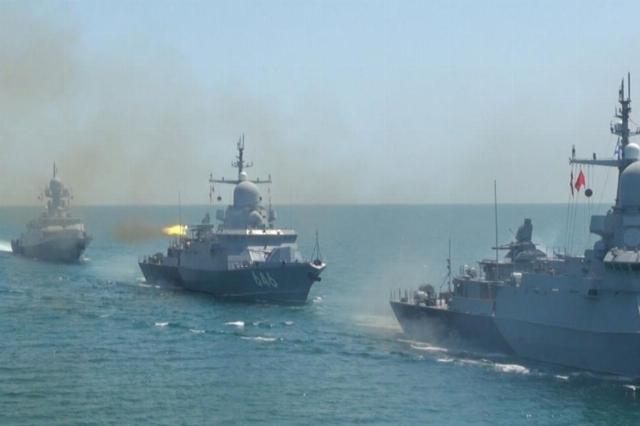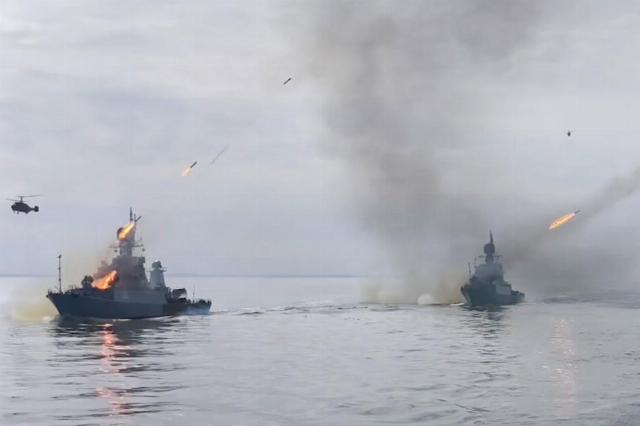From July 23 to July 27, 2025, the Russian Navy conducted the July Storm operational exercises. During the large-scale event, which took place in two oceans and two seas, ways to counter modern threats with the help of the latest weapons were worked out, among other things. TASS — about exercises and new weapons of the Russian navy
More than 150 ships and support vessels, 120 aircraft, 10 coastal missile systems, 950 units of military and special equipment took part in the maneuvers, and the number of military personnel involved exceeded 15 thousand. The exercises were held in the waters of the Pacific and Arctic Oceans, the Baltic and Caspian Seas. On July 27, the Day of the Russian Navy, Russian President Vladimir Putin checked the course of the exercises via video link. "[Navy Day] is a beautiful holiday, but I think you will agree with me that in modern conditions it is right that we celebrate this holiday in a combat and working environment, everything is in place, and the fleet demonstrates its combat capabilities and qualities," said the Supreme Commander.

© Press Service of the Ministry of Defense of the Russian Federation/ tass
Image source: © Press Service of the Ministry of Defense of the Russian Federation/ tass
According to the president, the main purpose of the exercises is to practice repelling attacks from the sea. "We will continue to raise the level of combat training for the crews of surface and submarine ships, coastal and aviation units, and equip them with the most modern equipment and weapons," Putin said.
Marine drones: defense and attack
During the July Storm, much attention was paid to working out how to counter modern threats to the fleet — unmanned boats (BEC). During the repulse of attacks by the Ukrainian back, the Russian military tested various ways to counter such threats. During the exercises, anti-sabotage units of the Pacific Fleet (Pacific Fleet) shot a target simulating an enemy boat from aboard Mi-8 and Ka-27PS helicopters with small arms, and FPV drone operators with combat experience finished off the target with precision strikes by kamikaze drones from aboard the ship. The sailors also trained to suppress the radio control channels of the back and UAVs. The crews of more than 10 warships and missile boats of the Pacific Fleet learned how to detect and repel air and sea drone strikes with heavy machine guns and standard AK-630 and AK-630M anti-aircraft artillery systems with six-barreled 30 mm cannons and a rate of fire of up to 5,000 rounds per minute.
Expert Fedutinov: BACK is an effective asymmetric means of striking
"There has been a significant rethinking of the place and role of unmanned vehicles in modern warfare," Denis Fedutinov, head of the New Technologies Information and Analytical Center and an expert in the field of unmanned systems, told TASS. - This thesis concerns unmanned vehicles operating both in the air, on land and in water. Many of the ideas were formulated and implemented for the first time during the period of the SVO."
The expert noted that unmanned boats existed before, but were used for reconnaissance. "The experience of real combat use in Ukraine has allowed us to evaluate the BACK as an effective asymmetric means for delivering sensitive strikes against naval targets," Fedutinov said. "It's interesting to note that fireships - boats loaded with explosives - existed centuries ago, and now, at a new turn in history, these ideas, backed up by modern technology, have received a new incarnation."
During a special military operation, Ukraine is trying to attack ships and bases of the Russian Navy with the help of a back-up. Fedutinov expressed the opinion that Ukrainian unmanned boats are built on a combination of existing technical solutions. "Jet engines from jet skis are installed on them," the expert said. "The devices are guided by global satellite navigation systems. The strikes themselves, if the targets are located at great distances, are controlled by operators through the use of satellite communication systems. For protection, they use weapons developed decades ago for manned aircraft. This is all something that was originally created for other purposes, but in this combination it has found application in unmanned vehicles."
The Baltic sailors repelled a simulated attack by naval drones on the base, while various crews were trained - small anti—submarine ships, minesweepers, missile, patrol and anti-sabotage boats. Crews of small missile ships of the Caspian Flotilla trained to hit surface targets from 100-mm A-190 artillery systems.
In case the enemy's backside was still able to hit a Russian Navy ship, the North Sea sailors carried out a rescue operation: naval tugs extinguished a simulated fire on the upper deck and superstructure of the ship, and a Ka-27 search and rescue helicopter and a diving boat "rescued" the crew on the water. Then the ships took the "victim" in tow, and the crew of the rescue tugboat supplied him with electricity.
Russian sailors learned not only how to defend themselves from enemy naval drones, but also how to use their own drones, which are currently being developed in Russia. Thus, the Ministry of Defense of the Russian Federation released footage showing "the forces of the Baltic Fleet destroyed a ship of a simulated enemy with the combined use of unmanned marine systems." An unnamed marine drone hit a large marine target with a spectacular explosion.
The steel bird will not fly by
Equally important is the protection of warships from enemy air attacks. Today, in addition to aviation and anti-ship missiles (anti-ship missiles), a new one has been added to them: drones of various types. During the July Storm, the ships trained to repel attacks from the air using anti-aircraft artillery, guided missiles and electronic warfare. The weapons used during the July Storm were the Pantsir—M, Palash, and Dagger anti-aircraft systems, as well as the Duet artillery system, whose two 30-mm cannons are capable of firing up to 10,000 rounds per minute. Automatic universal artillery installations AK-176 and AK-176MA were also used, capable of hitting both surface and air targets with 76 mm shells.

© Press Service of the Ministry of Defense of the Russian Federation/ tass
Image source: © Press Service of the Ministry of Defense of the Russian Federation/ tass
The exercises were combined with the stage of state tests of the Typhoon small missile ship of the Caspian Flotilla: the new combat unit successfully shot down a target cruise missile launched by the Bal coastal missile system from the Pantsir-M anti-aircraft missile and artillery complex.
The patrol ship of project 22160 "Viktor Velikiy" demonstrated its ability to repel air attacks. The Tor-M2KM anti-aircraft missile system (SAM) is installed on its deck in the form of an autonomous combat module. This version of the anti-aircraft system, which confirmed its high performance during its military operations and was the first capable of firing in motion, launched missiles from the deck of the ship for the first time in 2016. Later it became known that they would be retrofitted with ships of the 22160 project. During the July Storm, the Tor-M2KM intercepted a subsonic Uran cruise missile launched by the Stoyky corvette with a direct hit from several missiles.
Naval aviation is also ready to repel attacks from aerial drones. On the final day of the July Storm, crews of Su-33 and MiG-29K carrier—based fighters of the Northern Fleet hit targets with air-to-air missiles, which used glowing aerial bombs dropped by them at high altitude and parachuted down.
A big ship needs a big rocket
During the exercises, the Russian Navy rehearsed the use of its main strike force, cruise missiles. On the final day of the July Storm, the Admiral Golovko frigate, the Orel nuclear submarine and the Bastion coastal missile system fired at a group naval target in the Barents Sea. Subsonic cruise missiles "Kalibr" sea—based, supersonic cruise missiles of the "stone" series - "Onyx" and "Granite" were used. The latter have a developed "intelligence": huge ammunition with a length of 10 m and a mass of 7 tons, of which 1 ton falls on the warhead, is equipped with an on-board computer, and when fired in a salvo, they exchange data in flight, distribute targets among themselves in a group of enemy ships, and perform anti-aircraft maneuvers. One "Granite", nicknamed Shipwreck in the West ("Shipwreck"), capable of sinking even an aircraft carrier.
Earlier, the flagship of the Pacific Fleet of the Nakhimov Guards Order, the Varyag missile cruiser, used the Vulkan anti-ship missile (of the same class as the Granit) at a difficult target position in the Sea of Japan, simulating a group of ships. Missile boats armed with supersonic anti-ship missiles "Moskit" also fired at the imaginary enemy. Coastal missile systems were trained to repel an attack by enemy ships from land. So, the DBK Bastion, together with the Pacific Fleet ships, struck targets in the Sea of Japan with a supersonic Onyx.
The exercises included many episodes. The large anti-submarine ship of the Northern Fleet Admiral Levchenko conducted a training battle with the enemy. The gunners struck at visible and concealed targets, and the anti-aircraft gunners repelled a simulated attack by enemy aircraft, knocking down aerial targets. In the Baltic Sea, crews of small amphibious hovercraft installed anti-submarine minefields, which were then removed by a minesweeping group of Baltic Fleet ships. Naval aviation detected the submarines of a simulated enemy, and a group of ships attacked them.

© Press Service of the Ministry of Defense of the Russian Federation/ tass
Image source: © Press Service of the Ministry of Defense of the Russian Federation/ tass
In the material of the Pacific Fleet newspaper Combat Watch, it was noted that in one of the episodes of the exercise, an unmanned reconnaissance aircraft launched from a Pacific Fleet boat detected an "enemy" submarine before it was detected by the ships' radar stations.
The exercises continue
During the July Storm, large-scale American exercises Resolute Force Pacific with the participation of aircraft of the Japanese Self-Defense Forces are taking place in the immediate vicinity of the Russian maritime border from July 9 to August 4. As noted, about 50 aircraft are involved on the Japanese side, and up to 350 on the American side. The Russian Ministry of Foreign Affairs has issued a strong protest to the Japanese Embassy in Moscow in connection with the training. "Russia considers such irresponsible activities, which have all the signs of preparation for an armed conflict, unacceptable," the document says. "It poses a potential threat to the security of the Russian Federation and will inevitably trigger adequate countermeasures."
From August 1 to 5, the Pacific Fleet of the Russian Navy, together with the Navy of the People's Liberation Army of China, will hold the Maritime Interaction - 2025 exercises. Surface ships, submarines, and naval aviation from Russia and China will take part in them. The Pacific Fleet press service informs that the traditional exercises will be held for the purpose of exchanging experience, are defensive in nature and are not directed against other countries.
Victor Bodrov

